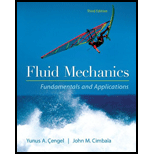
The updraft velocity of air motion.
Answer to Problem 64P
The updraft velocity of air motion is
Explanation of Solution
Given information:
The diameter of the dust particle is
Write the expression for the weight of the body.
Here, the drag force is
Write the expression for weight of the body in terms of density.
Here, the density of dust particle is
Write the expression for the drag force as per stokes law.
Here, the velocity of the dust particle is
Write the expression for the buoyant force.
Here, the density of air is
Write the expression for the volume of the dust particle.
Calculation:
Substitute
Substitute
Refer to Table A-9, “Properties of air” to obtain the values of
Substitute
Substitute
Substitute
Conclusion:
The updraft velocity of air motion is
Want to see more full solutions like this?
Chapter 11 Solutions
Fluid Mechanics Fundamentals And Applications
- The drag coefficient of a car at the design conditions of 1 atm, 70°F, and 60 mi/h is to be determined experimentally in a large wind tunnel in a full-scale test. The frontal area of the car is 22.26 ft2. If the force acting on the car in the flow direction is measured to be 68 lbf, determine the drag coefficient of this car.arrow_forwardWater at 10°C flows over a 1.1-m-long flat plate with a velocity of 0.55 m/s. If the width of the plate is 2.5 m, calculate the drag force acting on the top side of the plate. (Water properties at 10°C are: ? = 999.7 kg/m3, ? = 1.307 × 10−3 kg/m·s.) (a) 0.46 N (b) 0.81 N (c) 2.75 N (d ) 4.16 N (e) 6.32 Narrow_forwardWhat fluid property is responsible for the development of the velocity boundary layer? What is the effect of the velocity on the thickness of the boundary layer?arrow_forward
- A liquid (? = 850 kg/?3; ? = 1.7 × 10−1 Pa ∙ s) flows tangentially past a flat plate. If the free stream velocity is 2 m/s Question 1: what is the velocity 5 m downstream from the leading edge of the plateand 15 mm away from the plate. Question 2: if that plate is 10 m long and 3 m wide. Determine the drag force on the plate when liquid flows over both sides of the plate. (just only answer Question 2)!!!arrow_forwardDuring a winter day, wind at 58 km/h, 5°C, and 1 atm is blowing parallel to a 3.5-m-high and 9-m-long wall of a house. Approximating the wall surfaces as smooth, determine the friction drag acting on the wall. What would your answer be if the wind velocity has doubled? How realistic is it to treat the flow over side wall surfaces as flow over a flat plate?arrow_forwardWater at 10°C flows over a 4.8-m-long flat plate with a velocity of 1.15 m/s. If the width of the plate is 6.5 m, calculate the average friction coefficient over the entire plate. (Water properties at 10°C are: ? = 999.7 kg/m3, ? = 1.307 × 10−3 kg/m·s.) (a) 0.00288 (b) 0.00295 (c) 0.00309 (d ) 0.00302 (e) 0.00315arrow_forward
- Air at 250C and 1.0 bar is flowing over a flat plate with a velocity of 8 m/s. Determine: (i) The distance from the leading edge where the flow becomes turbulent (ii) The thickness of the boundary layer at that location.arrow_forwardA 0.80-m-diameter, 1.2-m-high garbage can is found in the morning tipped over due to high winds during the night. Assuming the average density of the garbage inside to be 150 kg/m3 and taking the air density to be 1.25 kg/m3, estimate the wind velocity during the night when the can was tipped over. Take the drag coefficient of the can to be 0.7.arrow_forwardHow does a winglet on the wing tip reduce induced drag? Which drag is higher if an aircraft is flying at 100knts and the L/Dmax is 120knts? How do you know this?arrow_forward
- Given the following measurements of mean winds and temperature from a 200-m mast inNetherlands on a September night: Table 1. Measurements of mean winds and temperature from a 200-m mast in Netherlands ona September night. Question: Solve for the roughness parameter (zo) and friction velocity (U*)arrow_forwardExplain boundary layer thickness?arrow_forwardA commercial airplane has a total mass of 150,000 lbm and a wing planform area of 1700 ft2. The plane has a cruising speed of 625 mi/h and a cruising altitude of 38,000 ft where the air density is 0.0208 lbm/ft3. The plane has double-slotted flaps for use during takeoff and landing, but it cruises with all flaps retracted. Assuming the lift and drag characteristics of the wings can be approximated by NACA 23012, determine (a) the minimum safe speed for takeoff and landing with and without extending the flaps, (b) the angle of attack to cruise steadily at the cruising altitude, and (c) the power that needs to be supplied to provide enough thrust to overcome drag. Take the air density on the ground to be 0.075 lbm/ft3.arrow_forward
 Principles of Heat Transfer (Activate Learning wi...Mechanical EngineeringISBN:9781305387102Author:Kreith, Frank; Manglik, Raj M.Publisher:Cengage Learning
Principles of Heat Transfer (Activate Learning wi...Mechanical EngineeringISBN:9781305387102Author:Kreith, Frank; Manglik, Raj M.Publisher:Cengage Learning
